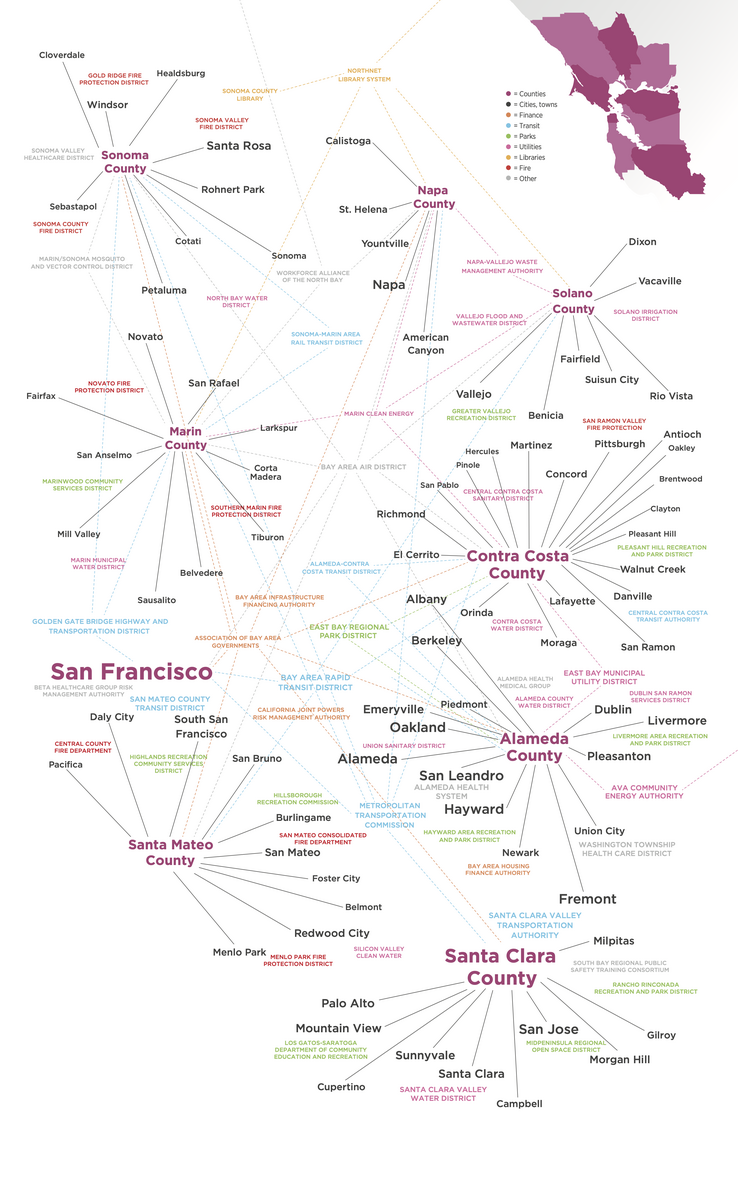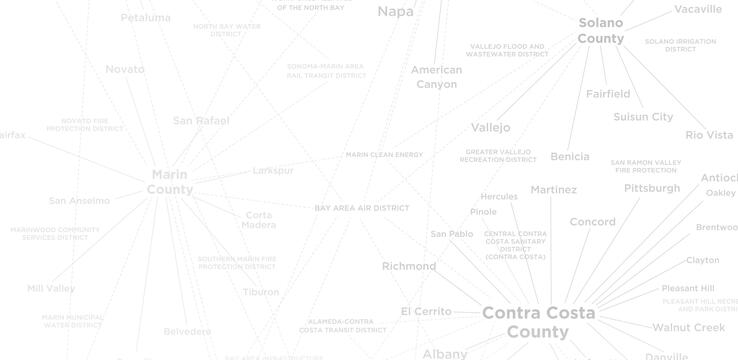The San Francisco Bay Area is one of the most prosperous regions in the world but prosperity has not been equitably shared, and our governance structures haven’t kept pace with the region’s growing complexity. We’ve built a patchwork of governments and special districts — nine counties, more than 100 cities, dozens of agencies — each operating largely within its own boundaries. (See “Who Governs the Bay Area?” below.)
Yet the challenges we face — a housing shortage, climate change, economic inequality, aging infrastructure — are regional in nature. If we are to meet this moment, we need regional governance systems designed to respond at the right scale, with the right tools. This integration will require new models for collaboration across the region’s many governments.
The Interdependent Web of Local Governments
The Bay Area’s governance landscape is complex and fragmented. The nine counties — San Francisco, Alameda, Contra Costa, Marin, Napa, San Mateo, Santa Clara, Solano, and Sonoma — each have their own governing boards, agencies, and priorities. Within them, more than 100 cities operate independently, with their own councils, planning departments, and land use policies. Adding to this institutional mosaic are dozens of special districts responsible for delivering essential services — such as water, public transit, and fire protection — and more than a dozen regional agencies, including the Metropolitan Transportation Commission, Association of Bay Area Governments, Bay Area Air District, and San Francisco Bay Conservation and Development Commission.
These overlapping institutions often operate in parallel rather than in concert. With local governments facing structural deficits, and regional goals requiring cross-jurisdictional action, the need for coordinated governance and shared resources is more urgent than ever.
Practices for Collaborative Regional Governance
Rather than start from scratch or consolidate existing agencies, the Bay Area can instead build on existing models that strengthen the ability to govern across boundaries. Learning from what’s already working, SPUR offers five practices for sharing resources and governing effectively across boundaries.
1. Organize Around Shared Challenges, Not Jurisdictional Boundaries
The most effective regional efforts center shared goals and challenges and align clear and compelling opportunities. When governance reflects real-world needs — like housing, procurement, or emergency response — and builds support networks across jurisdictions, it can create smarter solutions while building operational capacity to implement solutions.
Example: Bay Area Procurement Alliance
This cooperative purchasing consortium helps local governments reduce costs and streamline operations by pooling their buying power. Through shared contracts and vendor agreements, cities and special districts across the region can obtain equipment, technology, and services more efficiently. While still in its early stages, this collaboration has the potential not only to save taxpayer dollars but also to foster stronger interagency relationships that make future joint projects more feasible.
2. Use Funding to Incentivize Regional and Cross-Agency Action
Philanthropic and government funding can encourage alignment across local governments and among agencies. Grant programs that prioritize coordinated action are helping reshape the region’s governance landscape and are supporting more robust models of bottom-up collaboration.
Example: Transformative Climate Communities Grants
This California Strategic Growth Council program funds regional partnerships that center climate action and community engagement.
In East Oakland, the Better Neighborhoods, Same Neighbors initiative secured $28.2 million to build equitable climate resilience, thanks to the deep collaboration of city departments, community-based organizations, and developers. Funding not only seeded the project but also helped formalize and sustain the partnership.
3. Empower Regional Entities with Authority and Resources
Regional coordination must be backed by clear mandates and the tools to act: legal authority, staff capacity, and long-term funding. Joint powers authorities can be used to deliver more cost-effective services, eliminate duplicative efforts, and consolidate services for shared challenges such as emergency response and economic development. Regional finance authorities can help address regional housing needs by facilitating the development and preservation of affordable housing.
Example: Bay Area Housing Finance Authority
No single jurisdiction can solve the Bay Area’s housing affordability crisis on its own. The cumulative actions — or inaction — of local governments directly shape the availability and cost of housing across the region. Meanwhile, California’s statewide approach is challenged by the scale and diversity of its 40 million residents. Given this dynamic, certain housing challenges are better addressed at the regional level.
Recognizing this reality, California established the Bay Area Housing Finance Authority (BAHFA), the state’s first regional housing finance agency, in 2019. BAHFA has the authority to raise, allocate, and manage funding for affordable housing while supporting tenant protections and the preservation and production of housing across the nine-county Bay Area. By equipping BAHFA with real powers and resources, the state enabled a more coordinated, regional response to one of the Bay Area’s most pressing challenges.
4. Put Government in the Lead — But Share the Work
Solving the region’s biggest challenges will require partnerships that span sectors. Business leaders, philanthropies, and community organizations are increasingly stepping in to co-create solutions that reflect community needs and leverage private expertise and capital. Public-private partnerships bring community insight and private resources together with the legitimacy and authority of local governments.
Example: Oakland Undivided
During the COVID-19 pandemic, Oakland Undivided emerged to address the digital divide. This partnership of the City of Oakland, the Oakland Unified School District, philanthropies, and private companies provided thousands of students with laptops, internet access, and tech support. What began as emergency relief evolved into a long-term strategy to expand broadband access in digitally redlined neighborhoods like West Oakland, Fruitvale, and East Oakland. The cross-sector coalition and its local advocacy work have led to increased investment and the establishment of the Bay Area Digital Equity Coalition, a collaboration of 28 agencies serving Oakland, San Francisco, and Contra Costa County that seeks to ensure communities have the access and skills to fully participate in the digital world.
5. Embed Equity as a Mandate in Regional Governance
Equity must be more than an intention — it should be embedded in governance structures, funding decisions, and accountability measures. Regional governance systems should be explicitly tasked with directing resources to communities most in need.
Promising steps include equity scoring in infrastructure funding, prioritization of frontline neighborhoods in climate planning, and targeted support for under-resourced communities. State policy and regional agencies can and should be structured to prioritize racial, economic, and geographic equity in every decision.
Example: Equity Priority Communities Map
The Metropolitan Transportation Commission’s Equity Priority Communities map identifies neighborhoods with high concentrations of low-income residents, people of color, seniors, and other historically marginalized groups. This tool helps guide transportation planning and funding decisions to ensure investments reach those most impacted by disinvestment and structural barriers.
Looking Ahead
The Bay Area does not need to reinvent its governance structures. It does need a more coordinated and responsive approach to regional governance — one that follows promising practices rooted in equity, partnership, and shared outcomes. Organizing to meet shared challenges, leveraging funding to drive alignment, empowering regional structures, building effective public-private partnerships, and embedding equity mandates are all foundational steps toward a stronger, more inclusive Bay Area.
As the region’s climate, housing, and infrastructure challenges intensify, the urgency of regional governance reform grows — but so does the opportunity. The path ahead requires bold leadership and deep collaboration across cities, counties, sectors, and communities. If we get it right, the reward is great: a Bay Area that works for everyone, where all residents can thrive, no matter where they live. ✹
Who Governs the Bay Area? Governance in the Bay Area is shaped by a complex network of overlapping jurisdictions. A vast constellation of interconnected organizations — cities, counties, transit agencies, utilities, and special districts — must coordinate to make the region work. Also in the mix, though not shown here, are school districts, court districts, and special districts with fewer than 100 employees.


